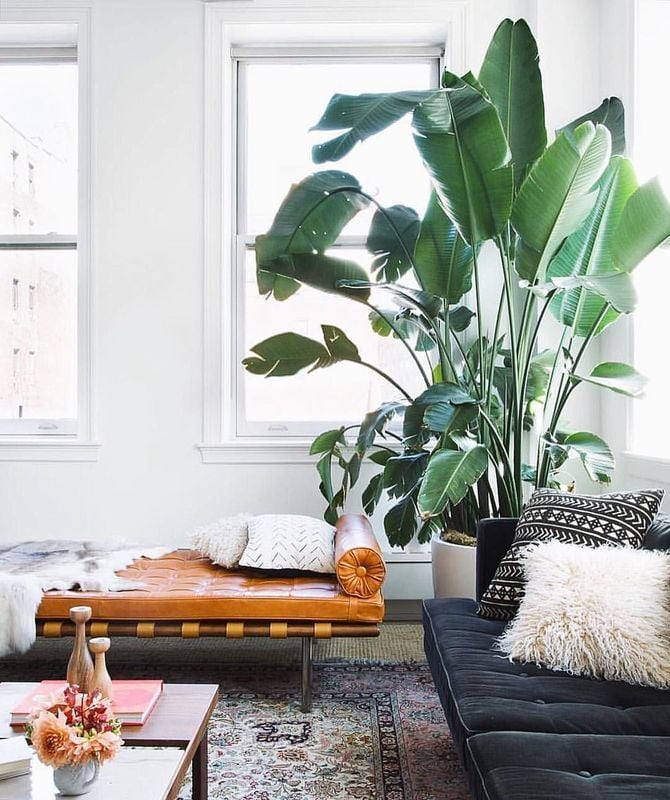8 low-maintenance indoor plants to buy in 2019
)
Whether you want to give your home a bit of a jungle vibe or you're looking for an easy way to add a splash of colour, there's an indoor plant for that. These are the house plants set to take over living rooms and lacklustre corners in 2019, plus how to care for them.
Indoor plants have seen a huge renaissance over the last few years. From cafes and offices to benchtops and bedrooms, indoor greenery has become synonymous with interior style and design. If you're looking for a little plantspiration, these are eight of the coolest - not to mention lowest maintenance - flora accessories for 2019. Plus how to keep them alive long enough to make your friends green with envy.
Devil's Ivy
This fast-growing vine (Epipremnum aureum) is a hardy, low-maintenance houseplant that loves low light full light and even artificial light, making it perfect for that shady corner in your kitchen that is desperate for a pop of greenery. Depending on your preferred aesthetic, this carefree ivy is ideal in hanging baskets or on floating shelves that allow its lush, green leaves to tumble down the wall. As an added bonus, it is also a great natural air purifier.
PERFECT FOR: Serial plant killers. This tough little guy thrives on neglect so it won't mind you forgetting to water it here and there.
LIGHT: Devil's Ivy flourishes pretty much anywhere, provided there is enough water. If kept in full shade, however, the leaves will lose their variegated look and turn a deeper shade of green.
WATER: Allow the soil to dry between watering. You can tell by sticking your finger into the potting mix.
Rubber plant
Move over fiddle leaf fig, 2019 is all about the rubber plant (Ficus elastica Burgundy). Whether you're looking for a medium-height pot plant or a statement indoor tree, this impressive house plant has you covered. If you are wanting your rubber tree to grow to great heights, start with a young tree as it will adjust to the indoor conditions better than more established plants. Being native to Southeast Asia, the rubber plant enjoys moisture and humidity, but can also weather less favourable conditions, such as air conditioning and winter cold snaps.
PERFECT FOR: Making a statement.
LIGHT: Rubber plants like bright, indirect light, so they're perfect near a window that has a curtain or blind that blocks some of the harsh sun.
WATER: The most common issue when it comes to rubber plant is overwatering. In winter, it might only need watering once or twice a month. This can increase to weekly during the warmer seasons. If leaves are droopy, this is a sign your Ficus needs more water, whereas browning or dropping leaves indicate overwatering. Also, remember to wipe over the leaves every month or so to ensure it is dust free and can breathe and absorb light properly.
Fiddle leaf fig
If you had to name the 'it' plant of interiors over the last couple of years, it would hands down be the humble fiddle leaf fig (ficus lyrata). And it's not hard to see why. This lush, indoor flora adds a beautiful, almost sculptural aesthetic to any space and can grow to impressive heights, making it the ideal indoor plant candy.
PERFECT FOR: Creating oh-so-Instaworthy spaces (hello, bedroom plant spam).
LIGHT: Fiddle leaf figs love living in sun-drenched spaces, but be careful not to place them in direct sun as the harsh rays can burn their delicate leaves. It turns out plants get sunburned, too.
WATER: Hydration is key when it comes to keeping your fiddle leaf healthy and happy. Instead of drip-feeding them one cup of water at a time, we recommend taking them outside, making sure they are dropping with water, then allowing the soil to dry out completely before the next drenching.
Monstera deliciosa
If you like the fiddle leaf fig, you'll probably love the equally aesthetic Monstera deliciosa or Swiss cheese plant. The once background bouquet leaf is now the latest interior lust-have, taking over from fiddles as the flora front runner for 2019. The best thing about the Monstera as that you can go as striking or as subtle as you like; opting for a full plant or, if you want to add a bit of bling to your benchtop, just a few leaves. Even a single frond in a vase can give a room an instant lush lift. And, for those of us black thumbs who can't quite seem to keep a plant alive but still want to add a little lush to our lives, the Monstera plant has blossomed into the artistic realm, with myriad artworks and wall prints paying homage to the patterned plant. You can even find quilt covers and soft furnishings brandishing its iconic leaf.
PERFECT FOR: Small spaces.
LIGHT: Bright, indirect sunlight is best. If you're using fresh-cut leaves in lieu of flowers, these generally last anywhere from one to three weeks.
WATER: Weekly, or whenever the top inch or so of soil feels dry (to test, stick your index finger in and see if there is any moisture). Look out for yellowing leaves, as this is a sign of over watering.
Snake plants
Give your home a bit of a jungle vibe with snake plant which is also known as sansevieria or mother-in-law's tongue. It's not just their striking silhouette that makes them an indoor plant lover's dream. These stripy, sword-grass looking plants are very hardy and also act as air purifiers, which makes them great for bedrooms, too.
PERFECT FOR: People who prefer independent plants that require little attention or care.
LIGHT: Indirect light, although they can manage pretty well in a variety of light conditions.
WATER: As long as you allow the soil to dry between feeds, your snake plant will be pretty happy. In fact, it'll probably flourish even if you forget to feed or water it (once every two-six weeks will do the trick). Just try to avoid wetting the leaves when watering, and be sure to use a pot that has good drainage as this plant can be prone to rot.
Boston fern
Boston ferns have long been relegated to balconies and back porches, but now it's time to let them spice up your indoor plant life. They are a great option for hanging greenery or shelf-plants as their fronds add a pop of vibrant, not to mention voluminous, colour. They're also non-toxic for cats and dogs.
PERFECT FOR: Pet owners.
LIGHT: These frilly little ferns love cool environments with high humidity and indirect light.
WATER: Boston ferns like their soil to remain damp so drip feed them water every few days (this also includes spraying the fronds) and give them a good soaking every month or so.
Umbrella plant
This droopy-leaved plant (schefflera, octopus tree) might be one of the most underrated indoor greenery gems, but we have a sneaking suspicion it won't be for long. The low-maintenance umbrella plant, with its long, svelte leaf limbs, is lovely, understated addition to your indoor plant jungle.
PERFECT FOR: Being ahead of the indoor plant trends.
LIGHT: While they do best in bright, dappled light, umbrella plants can usually tolerate direct indoor light, too. Just bear in mind low light may stunt their grow.
WATER: Umbrella trees like regular watering, but they also like to try out between feeds. They also don't like having wet feed so make sure there is adequate draining.
This post originally appeared at metricon.com.au is published here with permission.
) Author:Chris Collard
Author:Chris Collard| Tags:Property Investmentself employed home loansellingPropertyplanningRetirementStarting a BusinessReducing Debt |










